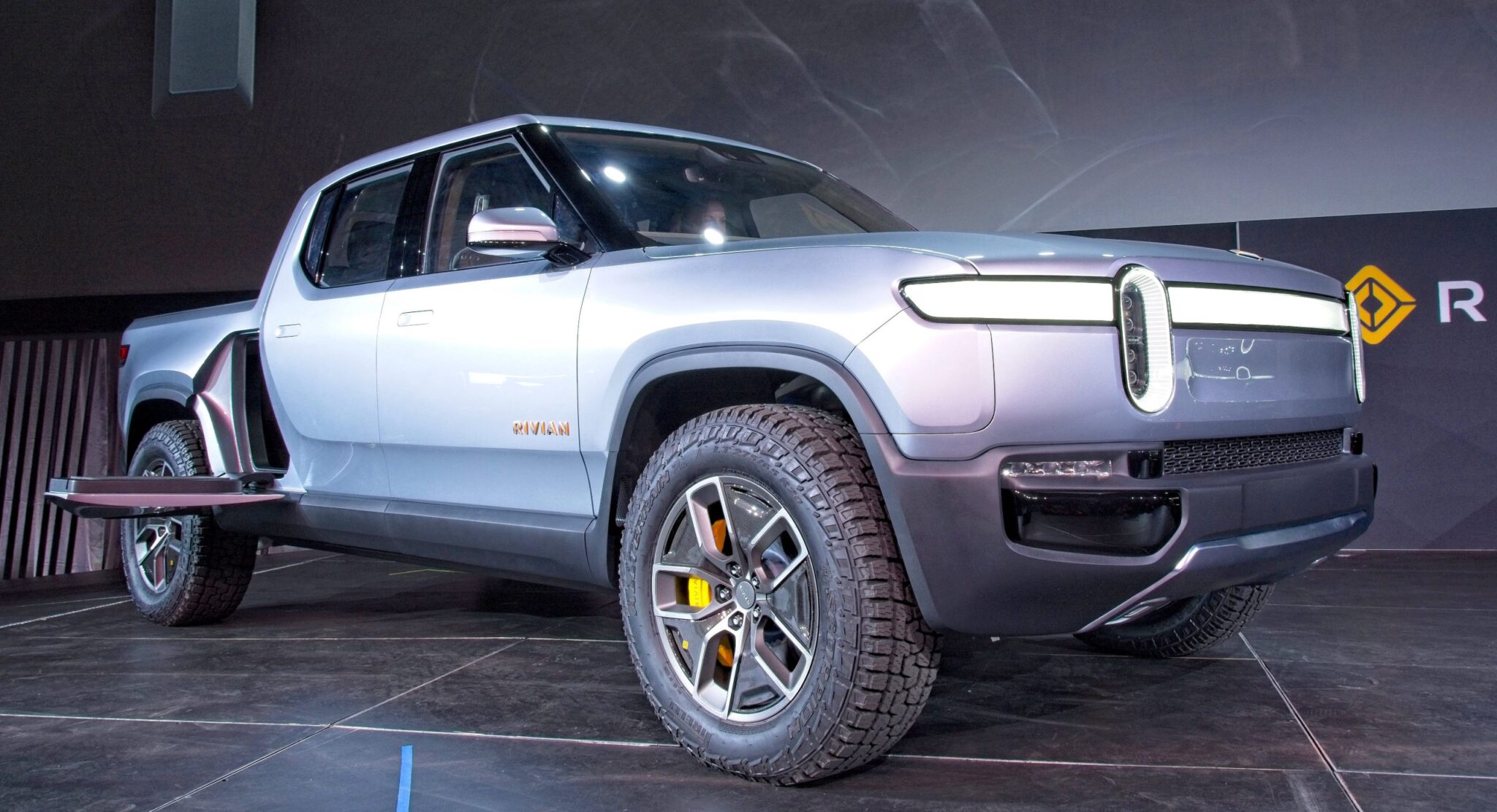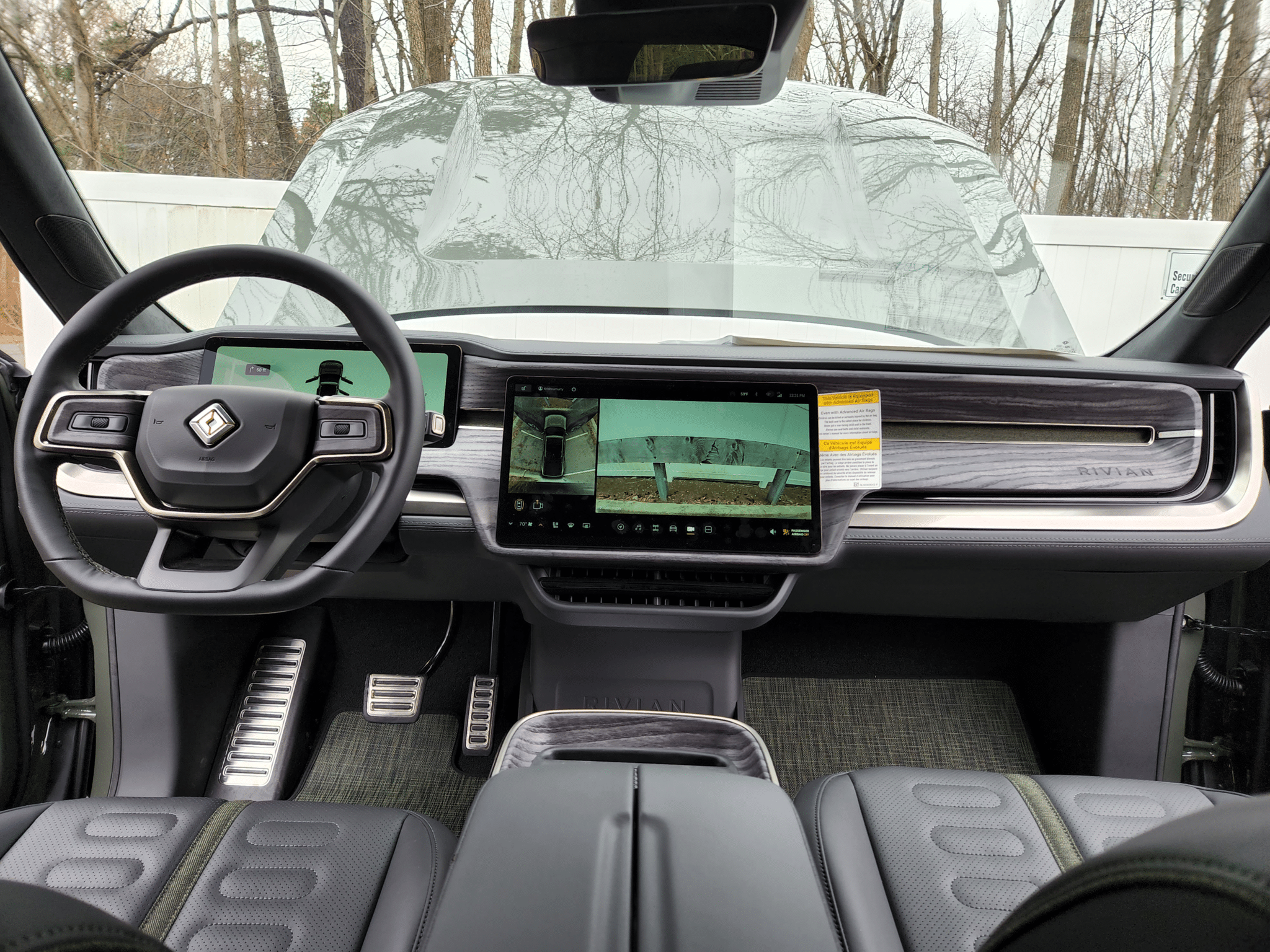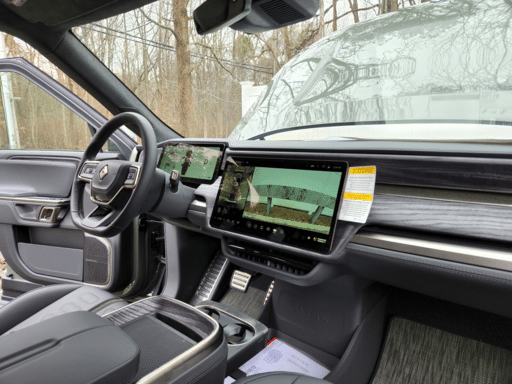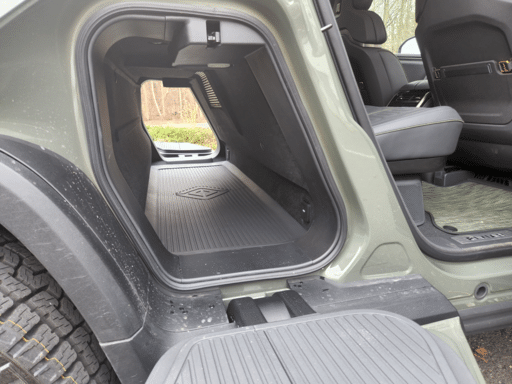Welcome to our Rivian R1T EV review!
The Rivian R1T is a battery-powered light-duty pickup truck made by Rivian, an American manufacturer. It’s one of the first electric trucks in production, with competitors that include the Ford F-150 Lighting, GMC Hummer EV and eventually the Tesla Cybertruck. Rivian unveiled the concept version in 2018. They then began production on the commercial version in September 2021 for the 2022 model year. Rivian has specially designed the R1T for off-road use. Let’s continue with the Rivian R1T review.

“File:Debut of the Rivian R1T pickup at the 2018 Los Angeles Auto Show, November 27, 2018.jpg” by Richard Truesdell is licensed under CC BY-SA 4.0.
EVU Hot Take:
Pros:
- High-end interior
- Drives and pulls like a sports car
- Gear tunnel is surprisingly useful
Cons:
- Not full sized
- Growing pains associated with a first run vehicle
- Doors are hard to close due to being water tight
Rivian R1T Trim Levels
The trim levels of the R1T initially included the Launch, Explore and Adventure, although the Launch trim sold out quickly. The Explore is the base trim and has a retail price of about $73,000. Similar to other manufacturers, this base trim includes several expandable features adding both price and functionality. A dual motor All-Wheel Drive (AWD) system is included with a quad-motor system obtainable for an additional $8,000.
Rivian offers 3 battery pack options for the R1T. The “standard pack” is included and offers an estimated 260 miles of range, but a “Large Pack” can be added for $6,000 (for a Rivian estimated 320 miles of range) and a “Max Pack” can be added for $16,000 (for a Rivian estimated 400 miles of range).
[cta_blog_section title=’Find your EV here!’ cta_url=’https://www.evuniverse.com/best-selling-electric-cars’ cta_button=’View Listings’]
Rivian R1T Exterior
The length of the Rivian R1T is 217.1 inches, and its width is 81.8 inches when the side mirrors are folded. The height varies between 72.1 and 78.3 inches, depending on the adjustable setting for the ground clearance. This size places the R1T between mid-size pickups like the Ford Ranger and full-size pickups like the Ram 1500.
The gross vehicle weight rating (GVWR) of the R1T is 8,532 pounds when the vehicle is loaded with its maximum payload of 1,700 pounds. The weight distribution of an unloaded vehicle is 51 percent in the front and 49 percent in the rear.

“Rivian R1T – 2nd Row 05” by Curlyrnd is licensed under CC BY-SA 4.0.
Rivian R1T Interior
The main console in the center of the dashboard has a display size of 15 inches, which controls infotainment, navigation and climate control. The hardware used by the R1T for assisted driving includes 12 ultrasonic sensors, 11 cameras and five radar sensors. The R1T has four interior 15A/120V AC electrical outlets. Two are located in the cargo bed, one is in the gear tunnel, and the other is in the front trunk.
The R1T’s gear tunnel is so-named because it’s located where the differential gear would be in a truck with a traditional transmission, under the rear seat. It’s a compartment that spans the truck’s entire width, so it’s best for storing long, narrow equipment like skis. You can access it from the exterior via drop-down panels between the wheels and rear doors, and from the interior via a small panel in the rear middle seatback.
Rivian R1T Batteries
As mentioned above, Rivian offers the R1T with a choice of three different battery sizes, including 105 kilowatt hours (kWh), 135 kWh and 180 kWh. The estimated range of the smallest battery is 260 miles. The estimated ranges of the 135-kWh and 180-kWh batteries are 320 miles and over 400 miles, respectively. Samsung makes the lithium-ion cells used by the R1T, which Rivian assembles into packs containing 7,776 cells. A flashlight on the driver-side door also contains the same cell as those in the main batteries.
Rivian R1T Charging
The maximum charge rate of the batteries in the Rivian R1T is 225 kW. It also supports the Plug & Charge feature, which allows an electric vehicle (EV) to automatically identify itself to a compatible charging station and authorize the recharging of its battery. This process involves the exchange of certificates via a certificate pool, which allows payment. The driver just needs to plug the charging cable into the EV.
Rivian has announced its plans to develop a network of charging stations for its EVs. As of March 2021, Rivian’s goal was to build 600 sites by 2023, at high-traffic locations such as lodging, dining and retail businesses. Rivian also plans to install stations in public parks at no cost to the government. Its current plan is to install two stations in each of up to 50 state parks in Colorado, in addition to other state recreation areas.
These stations will include a total of 3,500 fast chargers and 10,000 slower destination chargers. Rivian will also sell home charging units to its customers. The fast chargers will have an initial charging speed of 200 kW, which will eventually increase to 300 kW. The destination chargers will be Level 2 chargers with a charging speed of 11.5 kW.

“Rivian R1T – 2nd Row 04” by Curlyrnd is licensed under CC BY-SA 4.0.
Rivian R1T Powertrain
In the quad motor variant, each motor in the R1T drives its own wheel, which is monitored every millisecond for slip. This level of granularity allows the motors to precisely distribute power to each wheel as needed. The use of a separate motor for each wheel also lets the R1T to perform what Rivian calls a Tank Turn. This maneuver rotates the left wheels in the opposite direction to the right ones, spinning the truck on its axis.
The two front motors produce a total of 415 horsepower (hp) and 413 foot-pounds (ft⋅lb) of torque, while the two rear motors produce 420 hp and 495 ft⋅lb of torque. As a result, the total output for the Rivian R1T is 835 hp and 908 ft⋅lb of torque.
Rivian R1T Braking
The Rivian R1T has vented disc brakes for all wheels, with 13.5-inch discs in the front and 12.9-inch discs in the rear. It also provides regenerative braking, which charges the batteries with the energy collected from slowing the vehicle when you ease off the accelerator. The maximum force of the R1T’s regenerative braking is 0.21 g.
Rivian R1T Suspension
The R1T suspension system has a sophisticated architecture that provides dynamic roll control. The front suspension consists of adaptive dampers in a double-wishbone configuration, such that the two control arms are of unequal length. The rear suspension uses adaptive dampers in a multi-link configuration.
Rivian R1T Performance Review
The top speed of the Rivian R1T is limited to 111 mph by a governor. It accelerates to 60 mph in 3.3 seconds and 100 mph in 9.0 seconds. The standing ¼-mile time for the R1T is 11.9 seconds, with an ending speed of 110 mph. The braking distance of the R1T from 70 mph to a complete stop is 177 feet. Its lateral acceleration on a 300-foot skidpad is 0.80 g.
[cta_blog_section title=’Shop for EV parts and accessories.’ cta_url=’https://www.evuniverse.com/shop-ev-parts’ cta_button=’View Parts’]
Rivian R1T Energy Efficiency
The R1T’s drag coefficient is 0.30, which is extremely low for a truck. This aerodynamic efficiency is possible because heavy components like the batteries are located in the center of the vehicle, as is typical for EVs. The design also makes modifications for other body types comparatively straightforward.
The Environmental Protection Agency (EPA) has developed the Miles Per Gallon equivalent (MPGe) as a means of comparing the energy efficiency between EVs and fueled vehicles. This measure assumes that a gallon of fuel contains 33.7 kWh of energy, meaning that an EV requiring 33.7 kWh to travel 100 miles has an MPGe of 100. The EPA estimates that an R1T with the Adventure trim and 135-kWh batteries has an energy efficiency of 66 MPGe on the highway and 74.4 MPGe in the city, for a combined efficiency of 70 MPGe.
Rivian R1T Towing
The towing capacity of the Rivian R1T is 11,000 pounds. This figure was determined by a standard test on a desert road at temperatures exceeding 100 degrees Fahrenheit, as specified by the Society of Automotive Engineers (SAE). The R1T’s Class V tow hitch is behind a removable panel.

“Rivian R1T – 2nd Row 02” by Curlyrnd is licensed under CC BY-SA 4.0 .
Rivian R1T Storage
The cargo bed of the Rivian R1T is 4.5 feet, and its width between the wheel wells is 50 inches. The gear tunnel also provides a storage compartment that’s 65 inches long and has a volume of 11.6 cubic feet (cf), and is designed to store sports equipment and accessories. The front trunk is located under the hood, where the engine would be in a vehicle using internal combustion. This storage compartment has a volume of 11 cf.
Rivian R1T Off-Roading
The R1T has a number of features designed to improve its capabilities off paved roads. For example, it has an air suspension that allows you to adjust the ground clearance to between 7.9 inches and 14.4 inches with standard tires, which is most useful for traveling on rocky terrain. The maximum ground clearance is 14.9 inches with the optional 20-inch custom-made Pirelli 275/65 R20 all-terrain tires. The maximum wading depth of the R1T is 43.1 inches.
The custom drive modes of the Rivian R1T include the following:
- All-Purpose
- Sport
- Conserve
- Tow
- Off-Road
The Off-Road mode also has sub modes like Rally, Rock Crawl and Soft Sand. All of these modes adjust driving parameters such as ride height, suspension steering and throttle.
The Rivian R1T is available with a number of options for off-roading, including a reinforced underbody shield with tow hooks. It also has an option for a camp kitchen, which is highly useful during extended off-road expeditions. It includes two Dometic CI20 cooking elements, each with 1,440 watts of power. Additional equipment in the camp kitchen includes a sink, 30 pieces of outdoor cooking equipment and a roof-top tent big enough for three people. All of these components fit into the gear tunnel storage compartment. A winch controlled by Rivian’s iOS app is also available as an option for the R1T.
Rivian R1T Driver Assistance and Safety
The R1T’s primary driver assistance package is Driver+, which is similar to the AutoPilot technology by Tesla. This feature allows the vehicle to self-steer and control speed on selected highways based on the driver’s instructions. Drivers still have to watch the road while Driver+ is active, but the vehicle monitors the driver’s activities with its interior cameras. This driver mode is virtually autonomous on straight roads, but it requires input from the driver on curves. Standard safety features of the R1T include automated emergency braking, adaptive cruise control and lane-departure warning.
Rivian R1T Warranty Review
All versions of the R1T have a generous warranty plan, including a bumper-to-bumper limited warranty for five years or 60,000 miles, whichever comes first. The battery and powertrain warranty also provides separate protection for these components that last for eight years or 175,000 miles.
Sources
https://www.edmunds.com/car-news/tested-2022-rivian-r1t-is-the-quickest-and-best-handling-truck.html
https://www.fueleconomy.gov/feg/Find.do?action=sbs&id=44462
https://insideevs.com/news/533085/first-rivian-r1t-assembly-line/
https://www.engadget.com/2018/05/21/rivian-ev-truck-suv-detroit/

